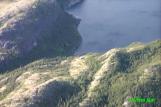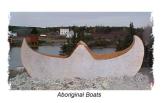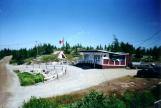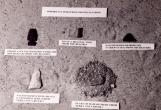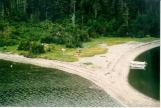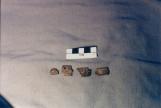2
According to archaeologists, Bonavista Bay is one of the oldest inhabited areas in Newfoundland. For about 5000 years native people resided in our beautiful region: Maritime Archaic Indians 3600 - 5000 years ago, Paleo Eskimo (Groswater & Dorset) 1300 - 2800 years ago, Recent Indians (Beaches, Little Passage, Beothuk) 250 -1200 years ago.Boats were an essential part of survival for these early inhabitants. Skillfully crafted, their boats allowed them to fish, hunt, transport goods and families. Due to the breakdown of boat materials, it's speculation what types of boats they actually built. Because these boats are no longer here for our examination, we must depend on the accuracy of such things as diaries and sketches from years gone by.
One excavation at a time archaeologists are revealing the exciting story of the rich history of the Glovertown area.
4
Much of the information and some of the pictures for the aboriginal portion of this exhibit came from the 'Burnside Heritage Foundation Inc.' Be sure to visit their interpretation centre and the archaeological sites located near picturesque Burnside, Newfoundland & Labrador, Canada. View their findings to date, take a half-day boat tour of the Quarry and The Beaches, and walk the archaeological sites as the aboriginal people did thousands of years ago. The project archaeologist will provide interpretation. To date, over fifty sites have been discovered in this area.To learn more about the archaeological discoveries, ongoing excavation projects, location and contact information of the 'Burnside Heritage Foundation Inc.,' please visit their website at www.burnsideheritage.ca
6
Transcription of Laurie McLean's sound clip recorded on November 5, 2003:"The Maritime Archaic Indians were the first people to live in Newfoundland and Labrador it seems. The Maritime Archaic occupation begins in Bonavista Bay about 5000 years ago. Radio carbon dated at "The Beaches" site which is about 13 kilometers from Burnside and a little further from Glovertown.
The Maritime Archaic, we're not sure when they left Bonavista Bay, but they were eventually succeeded or replaced by Groswater Paleo - Eskimos, and that took place throughout Newfoundland about 3000 - 2800 years ago. The Groswater Paleo - Eskimos were followed by the Dorset Paleo - Eskimos who lasted around til some thirteen to fourteen hundred years ago. They were then replaced throughout Newfoundland by Indian peoples from Labrador essentially. We call them the Recent Indians. There are three groups of Recent Indians consisting of the Beaches component, the Little Passage phase and finally the Beothuk. The Beothuk seem to have lived at the Beaches site until about 250 years ago when they left Bonavista Bay for good, and they persevered throughout other northern and central parts of Newfoundland for a hundred years or so after that.
Most of these 46 sites that we have found in this part of Newfoundland are scattered along the coastline. Their occupants utilized mainly marine resources, seals, sea birds and terrestrial animals that were accessible from the coastal sites, berries etcetera. Thus boat travel and boats, canoes, whatever would have been a vital component of those lifestyles. We don't get a lot of physical evidence for boats, of course, being made of organic materials. They just don't last in Newfoundland's highly acidic soils. So what we do is extrapolate backwards from historical documentation about Beothuk birchbark canoes and compare them with the tools you find and try to figure out what kind of boats would have been made by Beothuk peoples and older groups as well, the Eskimos and the Archaic."
7
Map of the Glovertown and Burnside area30 December 2003
Central Bonavista Bay, Newfoundland & Labrador, Canada
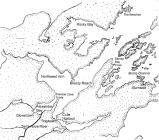
8
Bloody Reach, or Cowpath as it is locally known, contains many of the partially excavated archaeological sites in Bonavista Bay. Bloody Reach extends into Alexander Bay via Thimble Cove Tickle and in Alexander Bay, especially near the mouth of and upon the banks of the Terra Nova River, there are some already discovered and many other suspected aboriginal-inhabited sites. The locations of these sites suggest that hunting, fishing and birding were the major activities of Central Bonavista Bay's First Nations. Many waterways, many land and sea collisions, the changing seasons, the super-abundance of natural resources - all suggest a rich aboriginal lifestyle.And all suggest, too, that boats were of fundamental importance in that lifestyle.
10
At The Beaches, boats could be quickly hauled up and quickly launched - to go east or west, depending on the wind. The Beaches site excavations suggest that the Beaches was one of the largest Beothuk settlements in Newfoundland. Among the historical aboriginal nations that inhabited Newfoundland, the Beothucks live the most traditional lifestyle because they refused to be much influenced by the Europeans.12
These bone pendant fragments were excavated from house pit six, at The Beaches site.13
Aerial view of Bloody Bay Cove1998
Bloody Bay Cove, Bonavista Bay, Newfoundland & Labrador, Canada
